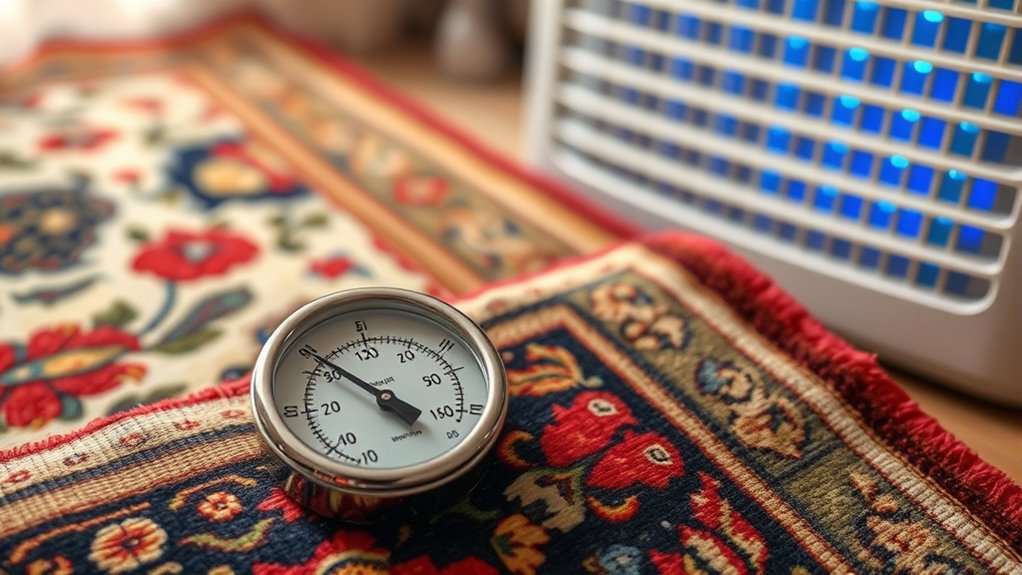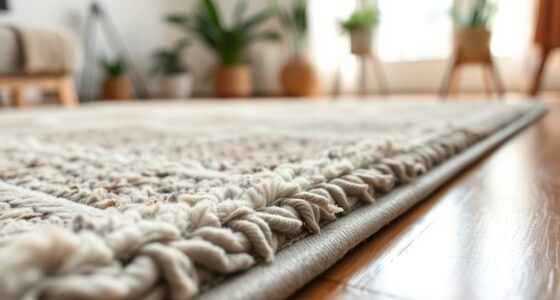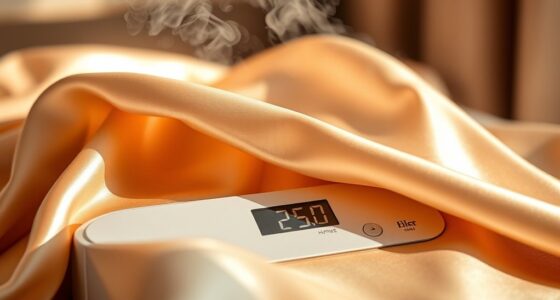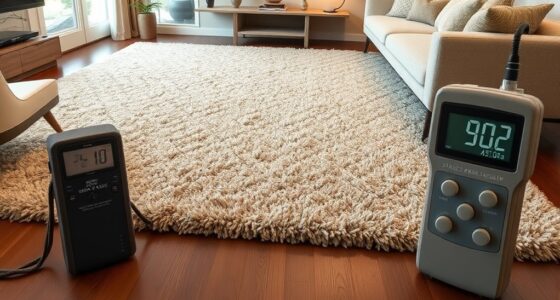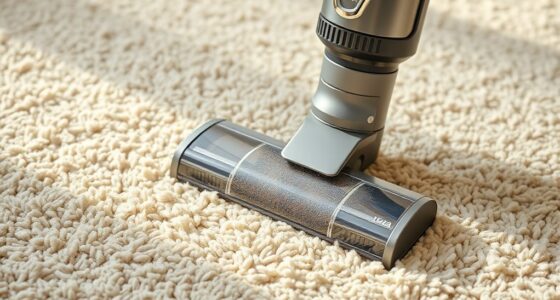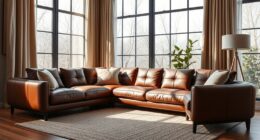To prevent rug dry‑rot, keep indoor humidity levels between 30% and 50%. Use a hygrometer to monitor humidity regularly and control moisture with dehumidifiers and good ventilation, especially in damp areas. Address leaks or condensation promptly, and ensure rugs have proper airflow. Maintaining stable humidity, cleaning regularly, and inspecting your rugs for early signs of damage help protect them long-term. Keep these tips in mind to create a dry environment; you’ll discover more ways to safeguard your rugs as you go.
Key Takeaways
- Maintain indoor humidity levels between 30% and 50% to inhibit mold growth and dry rot development.
- Use dehumidifiers and ventilation systems to control excess moisture and ensure proper airflow around rugs.
- Regularly monitor humidity with calibrated hygrometers to detect and address fluctuations early.
- Address leaks, condensation, and moisture sources promptly to prevent trapped water and fiber deterioration.
- Store rugs in well-ventilated, climate-controlled environments to ensure long-term dryness and preservation.
Understanding the Causes of Rug Dry‑Rot
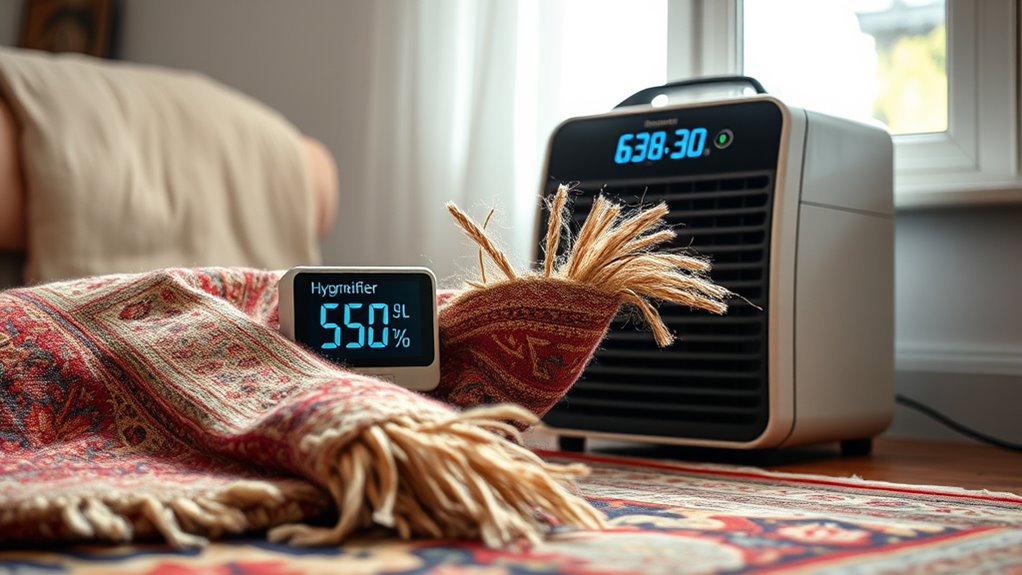
Dry-rot in rugs occurs when mold and fungi thrive in environments with high humidity and poor airflow. This creates conditions that cause rug fiber degradation, weakening the material over time. As fibers break down, the rug becomes fragile and more susceptible to damage. Pest infestation often accompanies dry-rot, as insects like carpet beetles and moths are attracted to decaying fibers, further accelerating deterioration. Moisture trapped in the rug provides an ideal breeding ground for these pests, which can cause additional harm. Without proper ventilation and moisture control, mold spores settle deep into the fibers, feeding on organic materials. Recognizing these causes helps you understand how humidity and neglect contribute to dry-rot, emphasizing the importance of keeping rugs dry and well-ventilated to prevent extensive damage. Additionally, proper maintenance can significantly reduce the risk of mold growth and pest infestation, prolonging the life of your rugs. Implementing humidity control measures is essential for maintaining optimal conditions and preventing the environment that fosters dry-rot. Regular use of air purifiers with HEPA filtration can help remove airborne mold spores and allergens, further protecting your rugs from deterioration. Maintaining adequate airflow and reducing excess moisture are crucial strategies supported by environmental controls to prevent dry-rot effectively.
The Role of Indoor Humidity Levels in Mold and Mildew Growth
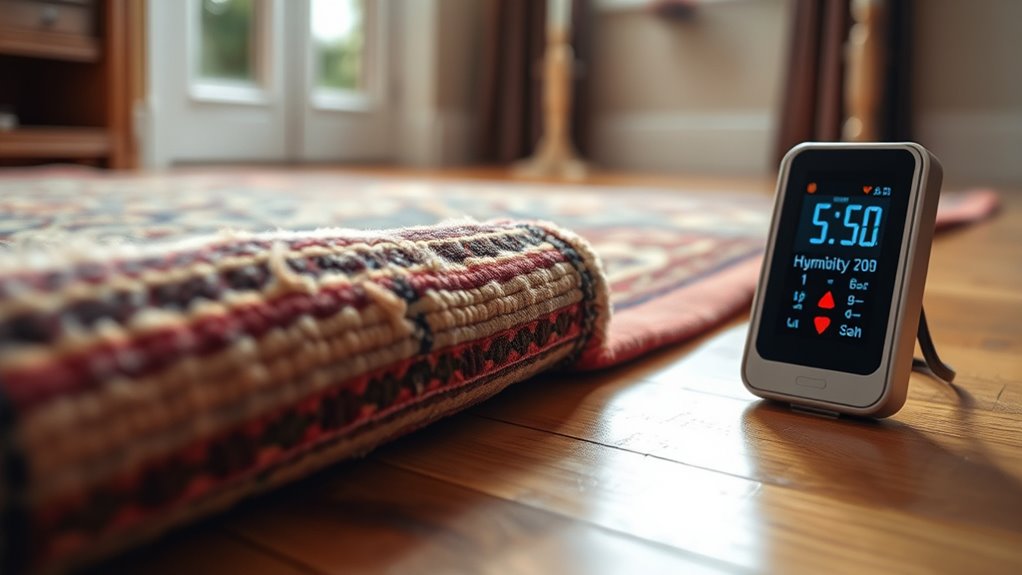
Maintaining the right indoor humidity levels is key to preventing mold and mildew growth. When humidity gets too high, the risk of these problems increases considerably. Keeping humidity within the ideal range helps you avoid excess moisture that fuels mold and mildew. Using a reliable airless paint sprayer can help ensure proper application of sealants and coatings to reduce moisture intrusion. Proper ventilation and humidity control techniques are also essential in maintaining optimal indoor conditions. Additionally, monitoring indoor air quality with air quality sensors can help detect humidity fluctuations early and prevent mold-friendly environments.
Optimal Humidity Ranges
Indoor humidity levels play a vital role in preventing mold and mildew growth, as these fungi thrive in moist environments. Maintaining the ideal humidity, typically between 30% and 50%, helps inhibit mold development. To achieve this, you should regularly perform humidifier maintenance, ensuring the device functions correctly and doesn’t add excess moisture. Seasonal humidity adjustments are also essential; during winter, humidity tends to drop, so you might need to increase it slightly, while in summer, reducing humidity prevents excess dampness. Keeping humidity within the recommended range supports a healthy indoor environment and protects your rugs from dry-rot. Proper monitoring and control of indoor humidity levels are crucial for a mold-free space. By staying attentive to these levels and adjusting your humidifier accordingly, you create a less hospitable environment for mold and mildew to flourish. Regular humidity monitoring helps detect fluctuations early and maintain optimal conditions. Additionally, understanding how indoor environments influence mold growth can help you implement effective measures to prevent it.
Excess Moisture Risks
When humidity levels rise above the recommended range, the risk of mold and mildew growth increases considerably. Historical moisture trends show that even slight increases can promote mold spores’ development, especially in hidden areas. Using humidity sensor technology helps you monitor indoor conditions accurately, providing real-time data to prevent excess moisture buildup. High humidity environments create an ideal environment for mold and mildew to thrive, damaging rugs and other organic materials. Without proper regulation, moisture can seep into fibers, accelerating dry-rot and deterioration. Recognizing these risks early allows you to take corrective action, such as adjusting your humidity levels or improving ventilation. Regular maintenance of indoor environments and understanding sound healing science can also contribute to a healthier home by reducing stress-related humidity fluctuations. Staying vigilant with reliable sensors ensures you keep moisture within safe limits, protecting your home from the dangers of excess moisture.
How to Measure and Monitor Humidity in Your Home
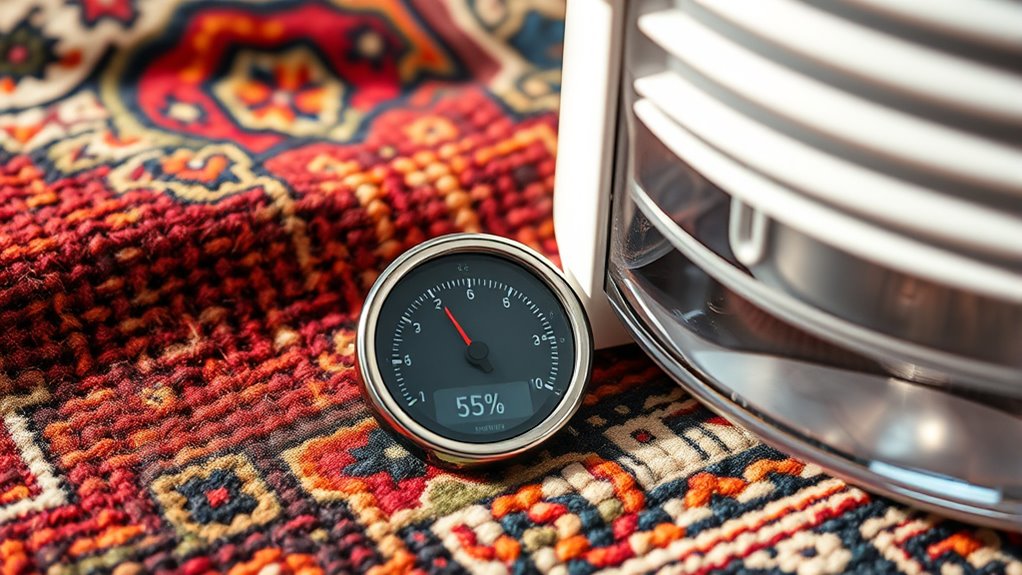
To keep your home comfortable and healthy, you need to measure and monitor humidity levels accurately. Choosing the right device, like a hygrometer, helps you track moisture effectively. Once you know your levels, maintaining them within the ideal range becomes simple and essential. Incorporating air quality indicators and AI-driven data analytics can further assist in optimizing humidity control for better home health.
Choosing the Right Device
How do you guarantee you’re accurately monitoring humidity levels in your home? The key is choosing the right device. A good humidity sensor provides precise readings, helping you stay within the ideal range. Look for sensors that are easy to read and connect to your smart home system if possible. An air purifier with integrated humidity monitoring can also help, especially if it includes a built-in humidity sensor. This allows you to track humidity and improve air quality simultaneously. Avoid cheap, unreliable devices that give inconsistent data. Instead, opt for a trusted brand known for accuracy. Properly monitoring humidity ensures you can make informed decisions to prevent rug dry‑rot and maintain a healthy environment. Incorporating sensor calibration into your routine can further enhance measurement accuracy and reliability, especially when you select a device with accurate sensing technology. Ensuring your device is regularly calibrated helps maintain measurement accuracy, which is crucial for effective humidity control.
Maintaining Optimal Levels
Once you’ve selected a reliable humidity sensor, regular measurement and monitoring become key to maintaining ideal indoor conditions. Keeping humidity levels between 40-50% supports antique preservation by preventing wood warping and mold growth. It also helps control pet allergens, reducing dust mites and mold spores that thrive in high humidity. Check your sensor daily and record readings to spot trends. Use this data to adjust humidifiers or dehumidifiers accordingly. Consistent monitoring guarantees you maintain a stable environment, protecting your valuables and improving indoor air quality. Avoid sudden fluctuations that can damage delicate items or worsen allergy symptoms. Regularly inspecting your humidity levels helps ensure optimal conditions, especially in areas prone to moisture buildup. Understanding monitoring devices and their proper use can help you interpret data more effectively. By staying vigilant and precise, you’ll create a balanced indoor climate that benefits both your belongings and your health. Additionally, understanding the AI security aspects related to monitoring devices can help safeguard your data and privacy.
Optimal Humidity Range for Protecting Your Rugs
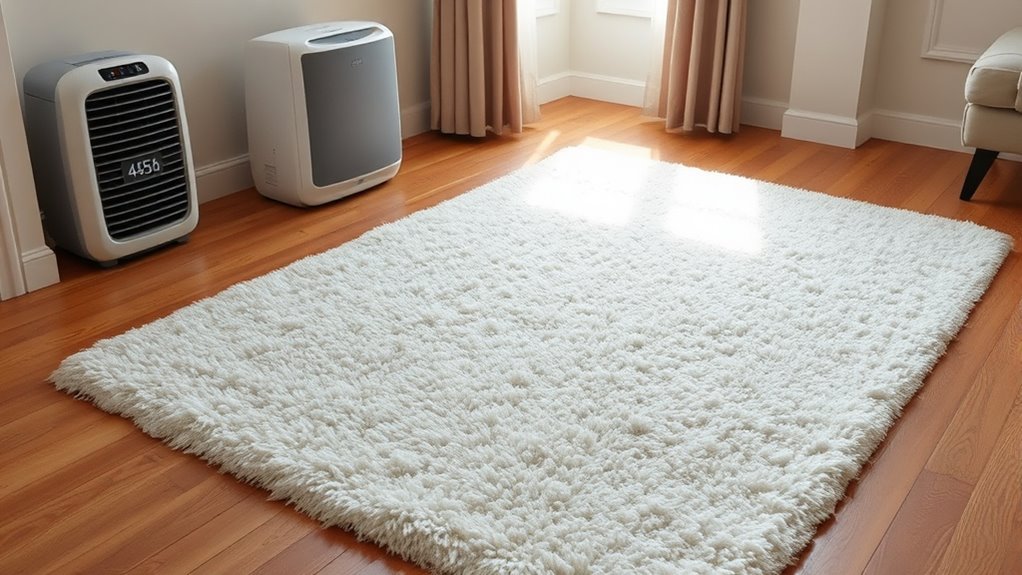
Maintaining the right humidity levels is essential for keeping your rugs in good condition. Ideally, you should aim for a humidity range between 40% and 60%. Staying within this range helps prevent the dry rot that can occur in too-dry environments and mold growth caused by excess moisture. To achieve this, ensure proper humidifier maintenance so it functions efficiently and accurately maintains your desired humidity. Additionally, maximizing airflow around your rugs prevents stagnant air and helps regulate moisture levels. Good airflow encourages even humidity distribution, reducing the risk of dry rot or mold spots. Regularly monitor your indoor humidity with a reliable hygrometer, and make adjustments as needed to stay within the ideal range, protecting your rugs from damage over time. Understanding mold growth is key to preventing long-term damage to your rugs and home environment. Incorporating humidity control techniques can further enhance your efforts to maintain optimal conditions. Furthermore, ensuring proper ventilation in your space can significantly reduce the likelihood of moisture buildup that leads to mold and dry rot.
Practical Strategies for Managing Indoor Moisture

To effectively manage indoor moisture levels, you need practical strategies that balance humidity and prevent issues like mold or dry rot. Installing humidity sensors helps you monitor real-time moisture levels, so you can make informed adjustments. Regularly check these sensors to maintain *ideal* humidity, typically between 30-50%. Additionally, applying mold-resistant treatments to vulnerable areas creates a protective barrier against mold growth. Keep an eye on potential moisture sources, such as leaks or condensation, and address them promptly. Using these tools and techniques, you can maintain a stable environment that safeguards your rugs and home structure. Consistent monitoring and proactive treatment are key to preventing dry rot and maintaining healthy indoor air quality over time.
Using Dehumidifiers and Ventilation Effectively
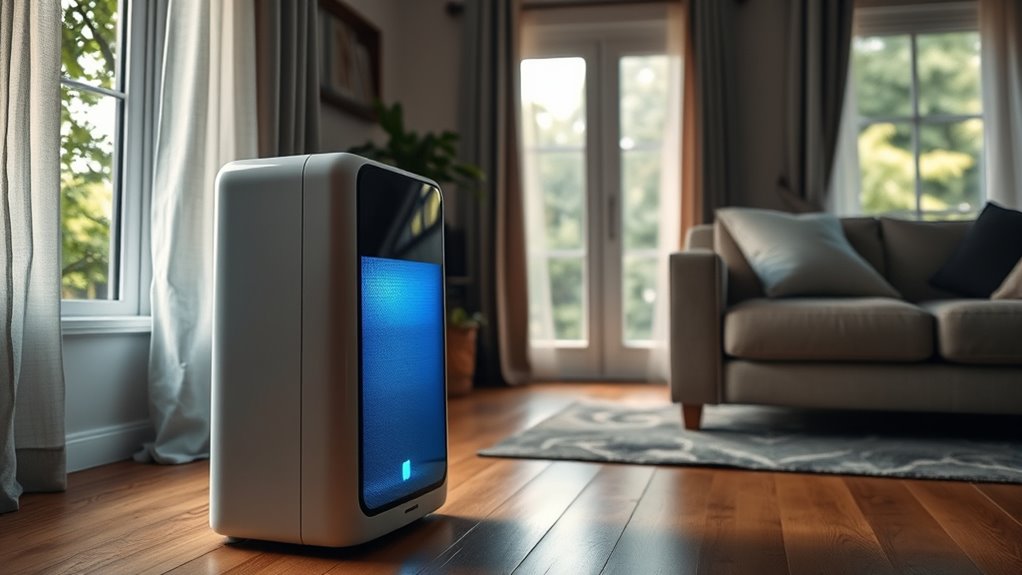
Using dehumidifiers and ventilation effectively is essential for controlling indoor humidity levels. Proper use enhances air quality and prevents rug dry‑rot. Dehumidifiers remove excess moisture, especially in damp areas, while ventilation systems exchange stale indoor air with fresh outdoor air, reducing humidity buildup. To optimize their use, set dehumidifiers to maintain indoor humidity around 50%. Ensure vents are open during activities that generate moisture, like cooking or laundry. Use exhaust fans in bathrooms and kitchens. Here’s a quick guide:
| Action | Benefit |
|---|---|
| Use dehumidifiers | Reduce excess moisture |
| Open vents | Improve air quality |
| Maintain humidity at 50% | Prevent dry‑rot |
| Run exhaust fans | Remove moisture during activities |
| Regularly check systems | Ensure efficiency |
Regular Cleaning and Maintenance Tips for Rug Preservation
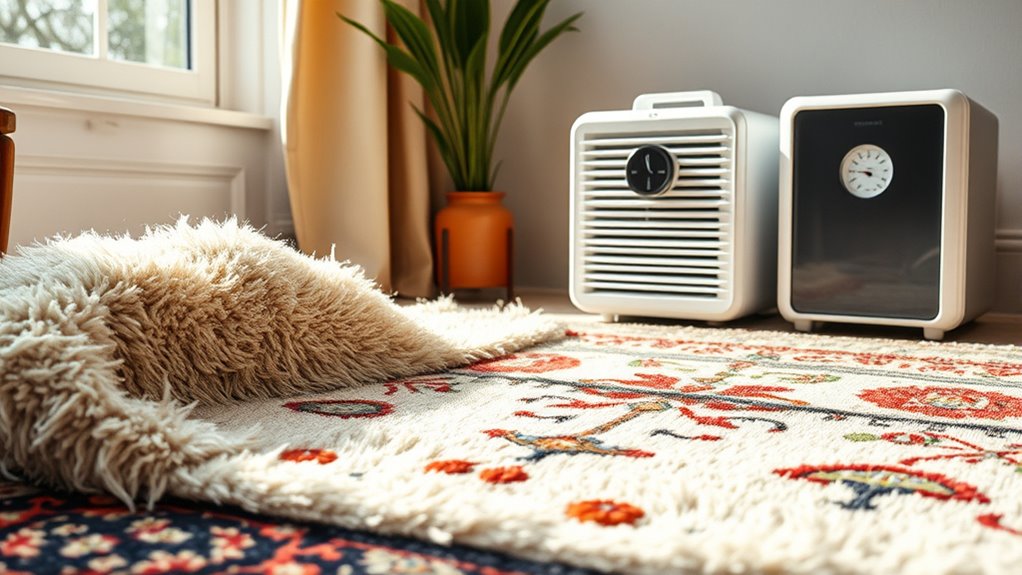
Regular cleaning and maintenance are essential to preserving the beauty and longevity of your rugs. Regular rug cleaning removes dirt, dust, and allergens that can weaken fibers and promote mold growth. Use gentle vacuuming weekly, making sure to reach the backing and fringes. When necessary, opt for professional rug cleaning to ensure deep fabric protection without damaging delicate fibers. Avoid harsh chemicals that could compromise your rug’s material, and instead choose eco-friendly solutions. Additionally, rotate your rugs periodically to prevent uneven wear and fading. Keep the rug dry and well-ventilated to prevent moisture buildup, which can lead to dry-rot. Proper fabric protection coupled with consistent cleaning extends the life of your rug, maintaining its appearance and structural integrity over time.
Identifying Early Signs of Dry‑Rot and Mold

Even with proper cleaning and maintenance, it’s essential to stay alert for early signs of dry-rot and mold that can endanger your rug’s health. In antique restoration and textile preservation, recognizing these signs early is critical. Look for musty odors or discoloration, which often indicate mold growth. Check for soft, spongy areas or peeling fibers, signs of dry-rot weakening the structure. Damp spots or water stains can also signal moisture buildup. Pay close attention to any unusual texture changes or a fuzzy growth, as these suggest mold colonies forming. Promptly addressing these signs helps prevent extensive damage and preserves your rug’s value. Regular inspections and early detection are your best defense against dry-rot and mold, ensuring your textile remains in pristine condition.
Long-Term Practices for Maintaining a Dry Environment
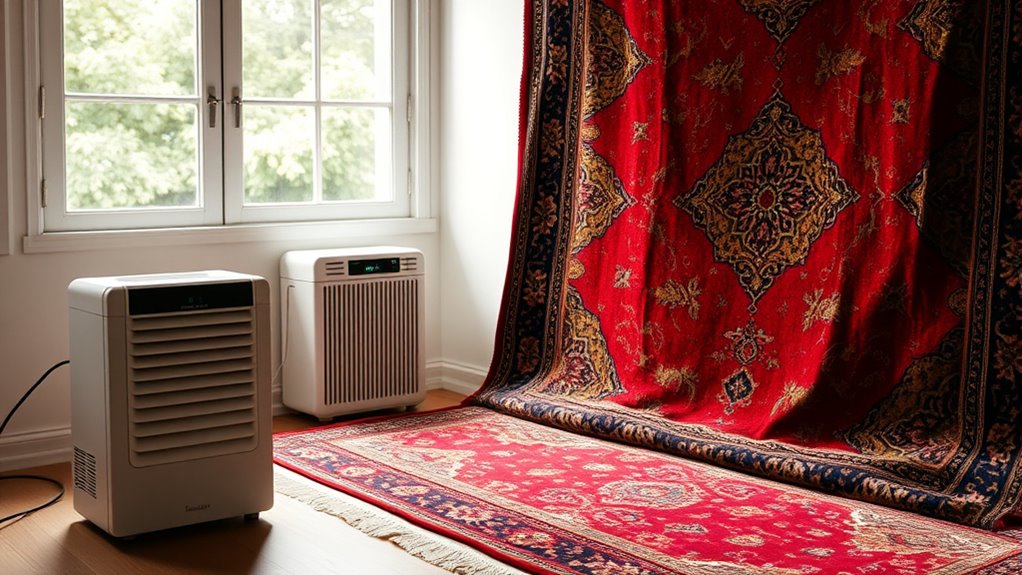
Maintaining a consistently dry environment is essential for preserving your rug’s integrity over the long term. Historical rug preservation methods emphasize controlling humidity and preventing moisture buildup to avoid dry rot. Regularly monitoring indoor humidity levels and using dehumidifiers keeps conditions ideal. Consider chemical treatments for dry rot if you notice early signs, as these can halt deterioration before it worsens. Proper storage is also key; store rugs in well-ventilated, climate-controlled spaces away from direct sunlight. Periodic inspections help catch issues early. Implementing these long-term practices ensures your rug stays dry and healthy, reducing the risk of dry rot and extending its lifespan. Staying proactive with humidity control and treatment options preserves both the beauty and value of your rug.
Frequently Asked Questions
Can Humidity Control Prevent Dry‑Rot in All Types of Rugs?
Controlling humidity helps prevent dry-rot in many rugs, but it doesn’t stop all issues. By managing moisture absorption, you reduce the risk of mold growth and dry-rot. However, some rugs still need proper cleaning and ventilation because high humidity can still cause mold and deterioration. So, while humidity control is essential, it’s best combined with other maintenance practices to protect your rugs effectively.
How Quickly Does Dry‑Rot Develop if Humidity Is Too High?
If humidity stays too high, dry-rot can develop quickly, often within a few weeks, especially in damp environments. You might notice mildew formation and mold growth on your rugs as moisture encourages these problems. To prevent this, you should keep humidity levels in check, guarantee proper ventilation, and regularly inspect your rugs for signs of moisture. Acting promptly helps you avoid extensive damage and preserves your rugs’ durability.
Are There Specific Materials More Susceptible to Dry‑Rot?
Think of some materials as sitting ducks for dry-rot. You’ll find that fabric susceptibility and material vulnerability vary, with natural fibers like wool and cotton more prone to mold and rot than synthetic ones like nylon or polyester. These organic materials provide a rich feast for mold spores when humidity rises. So, if you want to protect your rugs, pay close attention to the fabric susceptibility and choose durable, less vulnerable materials.
What Is the Best Way to Ventilate a Room With High Humidity?
To ventilate a room with high humidity effectively, you should consider dehumidifier options that suit your space. Use proper ventilation techniques like opening windows and installing exhaust fans to promote air circulation. Running a dehumidifier reduces moisture levels, preventing dry-rot. Combining these methods guarantees your room stays dry and well-ventilated, protecting your rugs and other materials from damage caused by excess humidity.
Can Natural Remedies Effectively Control Indoor Humidity Levels?
You wonder if natural remedies can effectively control indoor humidity levels. Natural remedies, like using houseplants, opening windows, and placing bowls of charcoal or baking soda, can help maintain a humidity balance. These methods actively absorb excess moisture and increase airflow, making your space more comfortable. While not as precise as dehumidifiers, natural remedies are eco-friendly options that support a healthier indoor environment by balancing humidity naturally.
Conclusion
Think of your rug as a delicate garden that needs just the right amount of moisture to thrive. By keeping your indoor humidity in check, you’re nurturing a healthy environment that prevents dry-rot and mold from taking root. Regular monitoring, proper ventilation, and mindful cleaning act as your gardening tools, helping you cultivate a space where your rug can stand tall and beautiful for years to come. Keep the balance, and your rug will flourish like a well-tended garden.
